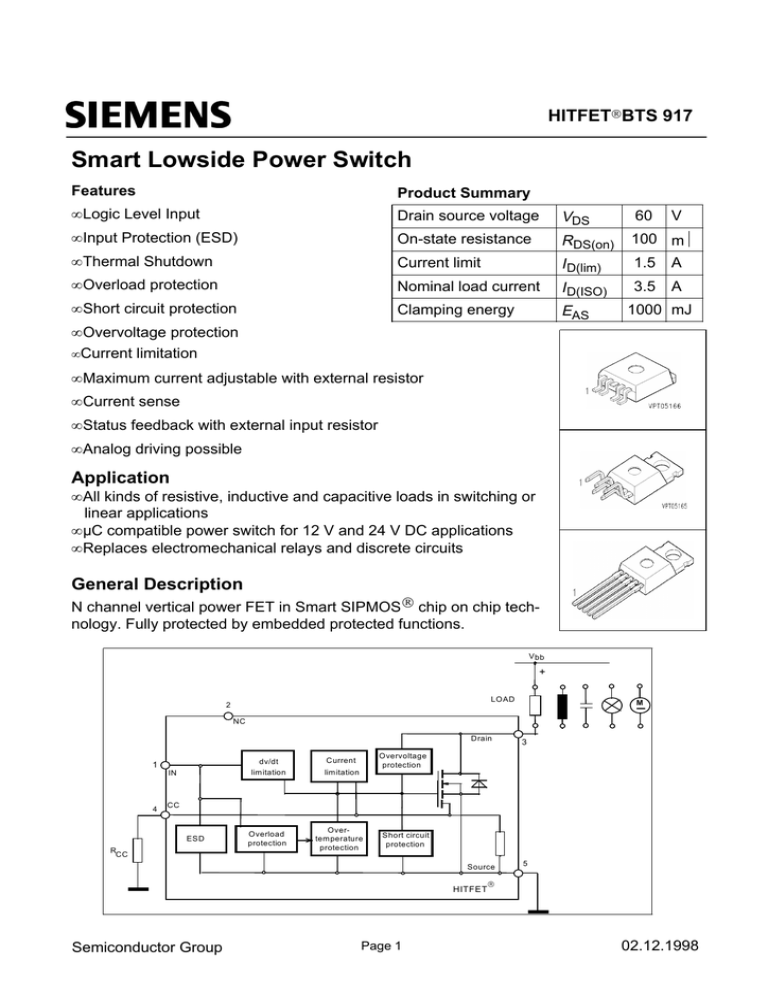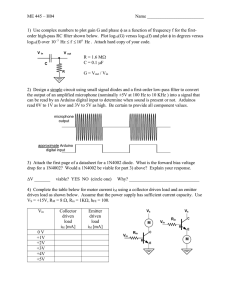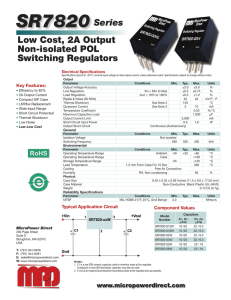
HITFETBTS 917
Smart Lowside Power Switch
Features
Product Summary
• Logic Level Input
Drain source voltage
VDS
60
• Input Protection (ESD)
On-state resistance
R DS(on)
100 mΩ
• Thermal Shutdown
Current limit
I D(lim)
1.5
A
• Overload protection
Nominal load current
I D(ISO)
3.5
A
• Short circuit protection
Clamping energy
EAS
V
1000 mJ
• Overvoltage protection
• Current limitation
• Maximum current adjustable with external resistor
• Current sense
• Status feedback with external input resistor
• Analog driving possible
Application
• All kinds of resistive, inductive and capacitive loads in switching or
linear applications
• µC compatible power switch for 12 V and 24 V DC applications
• Replaces electromechanical relays and discrete circuits
General Description
N channel vertical power FET in Smart SIPMOS chip on chip technology. Fully protected by embedded protected functions.
V bb
+
LOAD
2
M
NC
dv/dt
limitation
1
IN
4
Drain
3
Source
5
Overvoltage
protection
Current
limitation
CC
ESD
R
CC
Overload
protection
Overtemperature
protection
Short circuit
circuit
Short
protection
protection
HITFET
Semiconductor Group
Page 1
02.12.1998
BTS 917
Maximum Ratings at Tj = 25 °C unless otherwise specified
Parameter
Symbol
Drain source voltage
VDS
Drain source voltage for short circuit protection
RCC = 0 Ω
VDS(SC)
60
Unit
V
15
without RCC
Continuous input current
Value
50
mA
I IN
1)
-0.2V ≤ V IN ≤ 10V
no limit
VIN < -0.2V or VIN > 10V
| IIN | ≤ 2
Operating temperature
Tj
- 40 ... +150
°C
Storage temperature
T stg
- 55 ... +150
Power dissipation
Ptot
50
W
EAS
1000
mJ
3000
V
T C = 25 °C
Unclamped single pulse inductive energy
I D(ISO) = 3.5 A
Electrostatic discharge voltage (Human Body Model) VESD
according to MIL STD 883D, method 3015.7 and
EOS/ESD assn. standard S5.1 - 1993
Load dump protection V LoadDump2) = V A + VS
VIN=low or high; V A=13.5 V
V
VLD
t d = 400 ms, RI = 2 Ω, ID=0,5*3.5A
75
t d = 400 ms, RI = 2 Ω, ID= 3.5A
70
DIN humidity category, DIN 40 040
E
IEC climatic category; DIN IEC 68-1
40/150/56
Thermal resistance
junction - case:
RthJC
2.5
junction - ambient:
RthJA
75
SMD version, device on PCB: 3)
RthJA
45
K/W
1A sensor holding current of 500 µA has to be guaranted in the case of thermal shutdown (see also page 3)
2V
is setup without the DUT connected to the generator per ISO 7637-1 and DIN 40839
Loaddump
3Device on 50mm*50mm*1.5mm epoxy PCB FR4 with 6cm 2 (one layer, 70 µm thick) copper area for Drain connection. PCB is vertical
without blown air.
Semiconductor Group
Page 2
02.12.1998
BTS 917
Electrical Characteristics
Parameter
Symbol
at Tj=25°C, unless otherwise specified
Values
Unit
min.
typ.
max.
60
-
73
V
-
-
5
µA
1.3
1.7
2.2
V
IIN(1)
-
30
60
µA
Input current - current limitation mode, I D=ID(lim): I IN(2)
-
120
300
-
2200
4000
T j = 25 °C
500
-
-
T j = 150 °C
300
-
-
Characteristics
Drain source clamp voltage
VDS(AZ)
T j = - 40 ...+ 150°C, ID = 10 mA
Off state drain current
I DSS
VDS = 32 V, T j = -40...+150 °C, V IN = 0 V
Input threshold voltage
VIN(th)
I D = 0,7 mA
Input current - normal operation, ID<ID(lim):
VIN = 10 V
VIN = 10 V
Input current - after thermal shutdown, ID=0 A:
VIN = 10 V
I IN(3)
Input holding current after thermal shutdown
I IN(H)
On-state resistance
RDS(on)
mΩ
I D = 3.5 A, V IN = 5 V, Tj = 25 °C
-
90
120
I D = 3.5 A, V IN = 5 V, Tj = 150 °C
-
180
240
I D = 3.5 A, V IN = 10 V, Tj = 25 °C
-
80
100
I D = 3.5 A, V IN = 10 V, Tj = 150 °C
-
160
200
3.5
-
-
On-state resistance
RDS(on)
Nominal load current (ISO 10483)
I D(ISO)
A
VIN = 10 V, V DS = 0.5 V, TC = 85 °C
Semiconductor Group
Page 3
02.12.1998
BTS 917
Electrical Characteristics
Symbol
Parameter
at Tj=25°C, unless otherwise specified
Values
Unit
min.
typ.
max.
-
80
-
1.5
2.5
6
35
45
55
t on
-
40
70
t off
-
70
150
G9 '6GWRQ
-
1
3
G9'6GW RII
-
1
3
150
165
-
Characteristics
Initial peak short circuit current limit
ID(SCp)
A
VIN = 10 V, VDS = 12 V
Current limit 1)
ID(lim)
VIN = 10 V, VDS = 12 V, tm = 350 µs,
Tj = -40...+150 °C, without RCC
VIN = 10 V, VDS = 12 V, tm = 350 µs,
Tj = -40...+150 °C, RCC = 0 Ω
Dynamic Characteristics
Turn-on time
VIN to 90% I D:
µs
RL = 4,7 Ω, VIN = 0 to 10 V, Vbb = 12 V
Turn-off time
V IN to 10% ID:
RL = 4,7 Ω, VIN = 10 to 0 V, Vbb = 12 V
70 to 50% Vbb:
RL = 4,7 Ω, VIN = 0 to 10 V, Vbb = 12 V
Slew rate on
Slew rate off
50 to 70% Vbb:
V/µs
RL = 4,7 Ω, VIN = 10 to 0 V, Vbb = 12 V
Protection Functions
Thermal overload trip temperature
T jt
Unclamped single pulse inductive energy
EAS
°C
mJ
I D = 3.5 A, T j = 25 °C, V bb = 32 V
1000
-
-
I D = 3.5 A, T j = 150 °C, V bb = 32 V
225
-
-
-
1
-
Inverse Diode
Inverse diode forward voltage
VSD
V
I F = 5*3.5A, t m = 300 µS, V IN = 0 V
1Device switched on into existing short circuit (see diagram Determination of I
D(lim) . Dependant on the
application, these values might be exceeded for max. 50 µs in case of short circuit occurs while the
device is on condition
Semiconductor Group
Page 4
02.12.1998
BTS 917
Block Diagramm
Terms
Inductive and overvoltage output clamp
RL
I IN
V
Z
3
1
D
IN
ID
VDS
Vbb
S
HITFET
RCC
V IN
V
D
4
CC
S
5
CC
HITFET
Short circuit behaviour
The ground lead impedance of RCC
should be as low as possible
V IN
Input circuit (ESD protection)
I D(SCp)
I D(Lim)
ID
IN
ESD-ZD I
Source
t0
ESD zener diodes are not designed
for DC current > 2 mA @ VIN>10V.
t0:
tm:
t1:
t2:
Semiconductor Group
Page 5
tm
t1
t2
Turn on into a short circuit
Measurementpoint for ID(lim)
Activation of the fast temperature sensor and
regulation of the drain current to a level where
the junction temperature remains constant.
Thermal shutdown caused by the second
temperature sensor, achieved by an
integrating measurement.
02.12.1998
BTS 917
Maximum allowable power dissipation
On-state resistance
Ptot = f(Tc)
RON = f(Tj ); ID=3.5A; VIN =10V
BTS 917
200
55
mΩ
W
RDS(on)
45
Ptot
40
35
150
max.
125
typ.
30
100
25
75
20
15
50
10
25
5
0
0
20
40
60
80
100
120
°C
0
-50
160
-25
0
25
50
75
100
150
Tj
150
On-state resistance
Typ. input threshold voltage
RON = f(Tj ); ID= 3.5A; VIN=5V
VIN(th) = f(Tj); ID =0,7A; VDS=12V
250
2.2
mΩ
V
1.8
200
1.6
175
VIN(th)
RDS(on)
°C
max.
150
1.4
1.2
125
1.0
typ.
100
0.8
75
0.6
50
0.4
25
0
-50
0.2
-25
0
25
50
75
100
°C
150
Tj
Semiconductor Group
0.0
-50
-25
0
25
50
75
100
°C
150
Tj
Page 6
02.12.1998
BTS 917
Typ. transfer characteristics
Typ. short circuit current
I D = f(V IN); V DS=12V; Tj=25°C
IDlim = f(Tj); RCC =0Ω, VDS =12V
Parameter: VIN
40
60
A
A
10V
8V
ID
ID
40
20
30
6V
20
10
4V
10
3V
0
0
2
4
V
6
0
-50
10
-25
0
25
50
75
100
VIN
°C
150
Tj
Typ. output characteristic
Safe Operating Area
ID = f(VDS); T j=25°C
ID(SC) = f(VDS ); Tj =25°C
Parameter: VIN
40
60
10V
A
A
ID
ID(SC)
6V
20
40
30
5V
20
4V
10
10
Vin=3V
0
0
2
4
V
0
0
8
VDS
Semiconductor Group
10
20
30
V
50
VDS
Page 7
02.12.1998
BTS 917
Typ. current limit versus R CC
Typ. current sense characteristics
I D(lim) = f(RCC); T j=25°C
VCC = f(ID); VIN=10V
Parameter: VIN
Parameter: RCC , Tj
50
0.50
10V
18 Ohm
mV
47 Ohm
A
0.40
125°C
no Rcc
10 Ohm
VCC
ID
0.35
30
0.30
0.25
20
25°C
0.20
5V
0.15
10
0.10
0.05
0 0
10
10
1
10
2
10
Ω
RCC
3
0.00
0
4
8
12
16
20
24
A
30
ID
Transient thermal impedance
ZthJC = f(tP)
Parameter: D=t P/T
10 1
RthJC
K/W
10 0
D=0.5
0.2
0.1
0.05
10 -1
0.02
0.01
0.005
0
10
-2
10
-7
10
-6
10
-5
10
-4
10
-3
10
-2
10
-1
10
0
s
10
2
tP
Semiconductor Group
Page 8
02.12.1998
BTS 917
Application examples:
Current Sense Features and Status
Signals
IN
D
HITFET
µC
CC
V
bb
S
RCC
V
CC
IN
open
load
thermal
shutdown
V cc
V cc
reached triptemperature
The accuray of Vcc is at each
temperature about ±10 %
Status signal of thermal shutdown by
monitoring input current
R St
IN
µC
V
IN
D
HITFET
CC
V
bb
S
∆V
V
IN
thermal shutdown
∆V = RST *IIN(3)
Semiconductor Group
Page 9
02.12.1998
BTS 917
Package and ordering code
all dimensions in mm
Ordering code: Q67060-S6700-A4
Ordering Code: Q67060-S6700-A2
Ordering Code: Q67060-S6700-A3
Semiconductor Group
Page 10
02.12.1998
BTS 917
Edition 7.97
Published by Siemens AG,
Bereich Halbleiter Vetrieb,
Werbung, Balanstraße 73,
81541 München
© Siemens AG 1997
All Rights Reserved.
Attention please!
As far as patents or other rights of third parties are concerned, liability is only assumed for components,
not for applications, processes and circuits implemented within components or assemblies.
The information describes a type of component and shall not be considered as warranted characteristics.
Terms of delivery and rights to change design reserved.
For questions on technology, delivery and prices please contact the Semiconductor Group Offices in Germany
or the Siemens Companies and Representatives worldwide (see address list).
Due to technical requirements components may contain dangerous substances. For information on the types
in question please contact your nearest Siemens Office, Semiconductor Group.
Siemens AG is an approved CECC manufacturer.
Packing
Please use the recycling operators known to you. We can also help you - get in touch with your nearest sales
office. By agreement we will take packing material back, if it is sorted. You must bear the costs of transport.
For packing material that is returned to us unsorted or which we are not obliged to accept, we shall have to
invoice you for any costs incurred.
Components used in life-support devices or systems must be expressly authorized for such purpose!
Critical components1 of the Semiconductor Group of Siemens AG, may only be used in life-support devices or
systems2 with the express written approval of the Semiconductor Group of Siemens AG.
1)A critical component is a component used in a life-support device or system whose failure can reasonably be
expected to cause the failure of that life-support device or system, or to affect its safety or effectiveness of
that device or system.
2)Life support devices or systems are intended (a) to be implanted in the human body, or (b) to support and/or
maintain and sustain and/or protecf human life. If they fail, it is reasonable to assume that the health of the
user or other persons may be endangered.
Semiconductor Group
Page 11
02.12.1998












